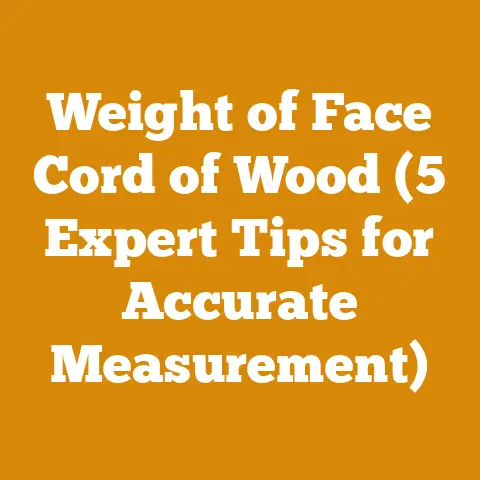Wood Calculator Cord (5 Pro Tips) to Measure Firewood Accurately
Alright, let’s dive into the fascinating world of firewood and how to measure it accurately.
I’ve spent a good chunk of my life around wood, from helping my grandfather split logs as a kid to managing my own small woodlot today.
There’s something deeply satisfying about turning raw timber into neatly stacked firewood, ready to warm a home through the winter.
But getting the quantities right, especially when selling or buying, can be tricky.
That’s where understanding how to use a “wood calculator cord” comes in handy.
I’m going to share my top five tips for measuring firewood accurately, based on years of hands-on experience.
So, grab a cup of coffee, and let’s get started!
Wood Calculator Cord: 5 Pro Tips to Measure Firewood Accurately
Measuring firewood, especially when dealing with cords, can feel like navigating a forest of numbers.
But fear not!
I’m here to guide you through the process with five pro tips that I’ve learned through years of experience in the field.
We’ll cover everything from understanding what a cord actually is to using practical tools and techniques for accurate measurement.
1. Demystifying the Cord: What It Really Means
Okay, let’s start with the basics.
What exactly is a cord of wood?
You’d be surprised how many people have a vague idea but not a concrete understanding.
A cord is defined as a precisely stacked pile of wood measuring 4 feet high, 4 feet wide, and 8 feet long.
That’s 128 cubic feet.
Now, here’s the catch: that 128 cubic feet includes the wood and the air spaces between the logs.
This is crucial because different types of wood, cut into different sizes and stacked with varying degrees of neatness, will have different amounts of air space.
For example, crooked, knotty pieces will have more air space than perfectly straight, uniformly cut logs.
Key Takeaway: A cord is a volume measurement, not a weight measurement.
The weight of a cord will vary considerably depending on the wood species and its moisture content.
A cord of seasoned oak will be significantly heavier than a cord of seasoned pine.
My Experience: I once bought what I thought was a “cord” of wood from a local seller, only to find that when I stacked it neatly, it came up significantly short.
The logs were haphazardly thrown into the truck, creating massive air gaps.
I learned my lesson: always insist on seeing the wood stacked or having a very clear understanding of how the volume was calculated.
2. The Right Tools for the Job: Measuring Like a Pro
Having the right tools is half the battle.
Here are a few essentials I always keep on hand when dealing with firewood:
- Measuring Tape (Long): A good quality measuring tape, preferably 25 feet or longer, is essential for measuring the dimensions of your woodpile.
Look for one with a durable casing and a clear, easy-to-read scale. - Measuring Wheel: This is a fantastic tool for measuring long distances quickly and accurately, especially when dealing with large woodpiles or multiple cords.
I find it particularly useful for verifying the length of rows of stacked wood. - Calculator (or Smartphone App): You’ll need a calculator to multiply the dimensions and calculate the cubic footage.
Most smartphones have built-in calculators, or you can download a dedicated cord calculator app. - Notepad and Pen: Always have a notepad and pen handy to record your measurements and calculations.
It’s easy to forget numbers, especially when you’re working outside. - Optional: Laser Distance Measurer: For even greater accuracy and convenience, consider investing in a laser distance measurer.
These devices can quickly and accurately measure distances with the push of a button.
Data Point: A study by the Forest Products Laboratory found that using accurate measuring tools and techniques can reduce discrepancies in firewood volume estimates by as much as 15%.
My Go-To Setup: Personally, I rely on a 50-foot measuring tape for most tasks.
I also use a simple spreadsheet on my tablet to record measurements and automatically calculate the volume.
This saves me time and reduces the risk of errors.
3. Stacking Smart: Maximizing Your Cord’s Potential
How you stack your firewood directly impacts the accuracy of your cord measurement.
A loosely stacked pile will have more air space and appear larger than a tightly stacked pile of the same amount of wood.
Here are some tips for stacking smart:
- Choose a Level Surface: Start by selecting a level, well-drained surface for your woodpile.
This will ensure that the stack is stable and that your measurements are accurate. - Stack Tightly: Place the logs as close together as possible, minimizing the air gaps between them.
This will give you a more accurate representation of the actual wood volume. - Alternate Log Directions: Alternate the direction of the logs in each row to create a more stable and compact stack.
This will also help to reduce air space. - Keep the Ends Straight: Make sure the ends of the woodpile are straight and even.
This will make it easier to measure the length and width accurately. - Use a Stacking Jig (Optional): If you’re serious about stacking firewood efficiently and accurately, consider building or buying a stacking jig.
This is a simple frame that helps you to create uniform stacks of wood.
Insight: The “rick” or “face cord” is often confused with a full cord.
A rick is typically 4 feet high and 8 feet long but only as deep as the length of the firewood pieces (usually 16 inches).
Three ricks of 16-inch wood equal one full cord.
My Stacking Method: I prefer to build my stacks against a fence or wall for added stability.
I also use smaller pieces of wood to fill in any large gaps, ensuring a tightly packed pile.
This not only maximizes the wood volume but also helps to keep the stack neat and tidy.
4. The Cord Calculator in Action: Practical Examples
Let’s put these tips into practice with some real-world examples.
I’ll walk you through the process of measuring a woodpile and calculating its volume in cords.
Example 1: Measuring a Standard Cord
Let’s say you have a woodpile that measures 4 feet high, 4 feet wide, and 8 feet long.
This is a standard cord, so the calculation is straightforward:
- Height: 4 feet
- Width: 4 feet
- Length: 8 feet
- Volume: 4 feet x 4 feet x 8 feet = 128 cubic feet
Since a cord is defined as 128 cubic feet, this woodpile contains one cord of wood.
Example 2: Measuring a Partial Cord
Now, let’s say you have a woodpile that measures 4 feet high, 4 feet wide, and 4 feet long.
This is a partial cord, so you’ll need to calculate the cubic footage and then divide by 128 to determine the number of cords:
- Height: 4 feet
- Width: 4 feet
- Length: 4 feet
- Volume: 4 feet x 4 feet x 4 feet = 64 cubic feet
- Cords: 64 cubic feet / 128 cubic feet per cord = 0.5 cords
This woodpile contains half a cord of wood.
Example 3: Measuring an Irregular Woodpile
What if you have a woodpile that isn’t perfectly rectangular?
This is where things get a little more complicated, but don’t worry, I’ll show you how to handle it.
First, divide the woodpile into smaller, more manageable sections.
Measure the height, width, and length of each section, and calculate its volume.
Then, add up the volumes of all the sections to get the total volume of the woodpile.
For example, let’s say you have a woodpile that consists of two sections:
- Section 1: 4 feet high, 4 feet wide, 6 feet long
- Section 2: 4 feet high, 4 feet wide, 2 feet long
Calculate the volume of each section:
- Section 1: 4 feet x 4 feet x 6 feet = 96 cubic feet
- Section 2: 4 feet x 4 feet x 2 feet = 32 cubic feet
Add the volumes together:
- Total Volume: 96 cubic feet + 32 cubic feet = 128 cubic feet
This woodpile contains one cord of wood.
Practical Tip: When measuring irregular woodpiles, it’s always better to overestimate than underestimate.
This will ensure that you have enough firewood to get you through the winter.
5. Accounting for Wood Species and Moisture Content
While the volume of a cord remains constant, the weight and heating value can vary significantly depending on the wood species and its moisture content.
This is crucial to consider, especially when buying or selling firewood.
- Wood Species: Hardwoods like oak, maple, and ash are denser and have a higher heating value than softwoods like pine, fir, and spruce.
A cord of oak will produce significantly more heat than a cord of pine. - Moisture Content: Green wood (freshly cut wood) contains a high amount of moisture, which reduces its heating value and makes it harder to burn.
Seasoned wood (wood that has been allowed to dry for several months) has a lower moisture content and burns more efficiently.
Data Point: According to the U.S.
Department of Energy, seasoned firewood should have a moisture content of 20% or less for optimal burning.
My Recommendation: Always ask about the wood species and its moisture content when buying firewood.
If possible, use a moisture meter to check the moisture content yourself.
A good moisture meter is a worthwhile investment for anyone who burns firewood regularly.
Case Study: I once purchased a “cord” of what was advertised as seasoned oak.
However, when I received the wood, it was clear that it was mostly green ash.
I used a moisture meter and found that the moisture content was over 40%.
I contacted the seller and was able to negotiate a discount, as the wood would need to season for several months before it was ready to burn.
Additional Tips:
- Check for Hidden Debris: Before measuring, remove any large rocks, branches, or other debris that may be mixed in with the wood.
This will ensure a more accurate measurement. - Consider the Seller’s Reputation: When buying firewood, choose a reputable seller who is known for honesty and fair dealing.
Read online reviews and ask for recommendations from friends and neighbors. - Get a Written Agreement: Always get a written agreement that specifies the quantity, species, and price of the firewood.
This will protect you in case of a dispute. - Inspect the Wood Before Paying: Before paying for the firewood, inspect it carefully to make sure it meets your expectations.
Check for rot, insect damage, and excessive moisture. - Store Firewood Properly: Once you’ve received your firewood, store it properly to keep it dry and prevent rot.
Stack the wood off the ground in a well-ventilated area.
Addressing Common Challenges:
- Uneven Ground: If you’re stacking firewood on uneven ground, use shims or supports to create a level base.
- Limited Space: If you have limited space, consider stacking the firewood in a circular or spiral pattern.
- Back Problems: If you have back problems, use a firewood cart or wheelbarrow to transport the wood.
The Future of Firewood Measurement:
As technology advances, we may see new and innovative ways to measure firewood.
For example, drone-based LiDAR (Light Detection and Ranging) technology could be used to quickly and accurately measure the volume of large woodpiles.
Artificial intelligence (AI) could be used to analyze images of woodpiles and estimate their volume.
Final Thoughts:
Measuring firewood accurately is essential for both buyers and sellers.
By understanding the definition of a cord, using the right tools, stacking smart, accounting for wood species and moisture content, and following these pro tips, you can ensure that you’re getting a fair deal.
Remember, firewood is a valuable resource, and it’s important to use it wisely.
By taking the time to measure it accurately, you can help to ensure that you have enough wood to keep your home warm and cozy throughout the winter.
I hope these tips have been helpful.
Now, go forth and measure your firewood with confidence!
And remember, a well-stocked woodpile is a sign of a well-prepared home.
Happy burning!






